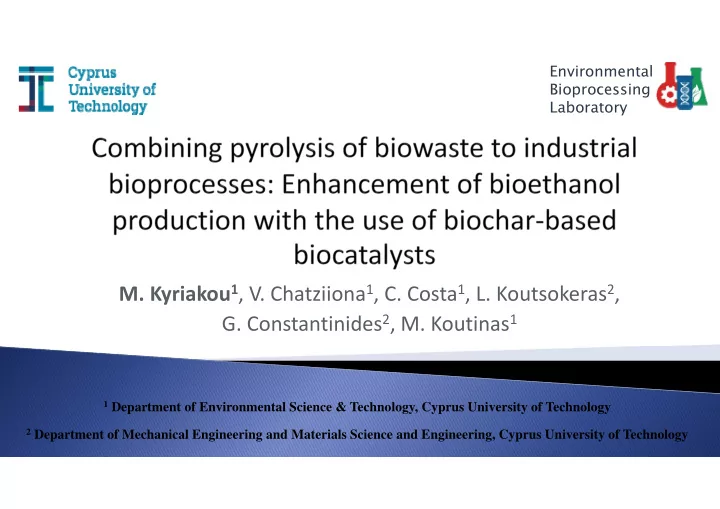

Environmental Bioprocessing Laboratory M. Kyriakou 1 , V. Chatziiona 1 , C. Costa 1 , L. Koutsokeras 2 , G. Constantinides 2 , M. Koutinas 1 1 Department of Environmental Science & Technology, Cyprus University of Technology 2 Department of Mechanical Engineering and Materials Science and Engineering, Cyprus University of Technology
Carbon ‐ rich material Produced from biomass (such as wood, manure or leaves) through the pyrolysis process Thermal decomposition of organic material under limited supply of oxygen (O 2 ), and at low temperatures (<700 °C) Pyrolysis Solid Liquid Gas ‐ Biochar ‐ Bio oil ‐ Syngas
Environmental remediation Soil amendment Removal of organic pollutants Mitigate climate change Industrial interest where it could be employed as a renewable and low ‐ cost support material
Attachment Entrapment Aggregation Containment
High biomass concentration Easy separation of the biomass from the liquid Increased product yield Increased product stability Imparts a special stability to the microorganism against environmental stresses Protects cell from shear forces
Produce biochar from different feedstock Study the industrial application of biochar Economical substitute to the activated carbon Bioethanol production
Vineyard prunings Seaweed Olive kernels Sludge Biomass sources Pyrolysis 250 ᵒ C and 500 ᵒ C Char of non biological origin Biochar Succinic acid Material Immobilization characterization Ethanol
• Porosity • Phase identification of a • Structure crystalline material • Surface characteristics • Information on unit cell SEM XRD dimensions • Elemental analysis BET EDX • Specific surface area • Composition & percentage
Halite (NaCl) Calcite (CaC0 3 ), Silicone (Si)
Mag: 3000x
Non ‐ biological char Mag: 3000x
Olive kernels 500 ᵒ C 250 ᵒ C Vineyard prunings 250 ᵒ C 500 ᵒ C
Sludge 250 ᵒ C 500 ᵒ C Non ‐ biological char Seaweed
Temperature BET specific surface Samples area (m 2 g ‐ 1 ) ( ᵒ C) 250 0.1479 Olive kernels 500 1.5181 250 0.4701 Vineyard prunings 500 41.7288 250 0.6914 Sludge 500 1.3559 250 1.9143 Seaweed 500 5.3247 ‐ 72.9874 Non ‐ biological char
Kluyveromyces Vineyard prunings marxianus Pichia kudriavzevii Seaweed Immobilized cells Free cells KVMP 10 Non ‐ biological Saccharomyces char cerevisiae Bioethanol production
Liquid media simulating Valencia orange peel waste hydrolysate that consisted of (g/l): Fructose 33.2 Galactose 8.6 Glucose 57.4 Sucrose 1.4 Saccharomyces cerevisiae Kluyveromyces marxianus Pichia kudriavzevii KVMP 10
Liquid media simulating Valencia orange peel waste hydrolysate that consisted of (g/l): Saccharomyces cerevisiae 90 Fructose 33.2 80 Galactose 8.6 70 60 Glucose 57.4 Ethanol (g/l) 50 Sucrose 1.4 40 30 20 10 Vineyard prunings biochar 77 g/l 0 Seaweed biochar 70 g/l 0 3 6 9 12 15 18 21 24 27 30 33 Time (h) Free suspended cells 68 g/l
• Pyrolysis temperature 500 ᵒ C Physicochemical characteristics Potential use • Bioethanol production using freely suspended cells S. cerevisiae produced 51 g/l bioethanol at 37 ᵒ C K. marxianus produced 45 g/l bioethanol at 42 ᵒ C P. kudriavzevii produced 44 g/l bioethanol at 42 ᵒ C • Bioethanol production using immobilized cells of S. cerevisiae Vineyard prunings biochar 77 g/l Seaweed biochar 70 g/l Free cells of S. cerevisiae 68 g/l
Initial sugar Ethanol Substrate Support material Yeast Literature concentration (g/l) production (g/l) FREE CELLS P. kudriavzevii Valencia orange peel model solution ‐ 101.0 54.0 Koutinas et al., 2015 KVMP 10 Valencia orange peel model solution ‐ K. marxianus 101.0 37.1 Wilkins et al., 2007 Valencia orange peel model solution ‐ S. cerevisiae 101.0 40.9 Wilkins et al., 2007 Valencia orange peel model solution ‐ S. cerevisiae 101.0 Grohmann et al., 1994 40.0 ‐ 45.0 P. kudriavzevii Valencia orange peel model solution ‐ 101.0 Current study KVMP 10 44.0 Valencia orange peel model solution ‐ 101.0 Current study K. marxianus 45.0 Valencia orange peel model solution ‐ 101.0 Current study S. cerevisiae 51.0 IMMOBILIZED CELLS Glucose Sodium alginate S. cerevisiae 50.0 52.0 Najafpour et al., 2004 Beet molasses Sodium alginate S. cerevisiae 250.0 53.0 Roukas 1996 Glucose γ‐ alumina S. cerevisiae 113.0 80.0 Kana et al., 1989 Valencia orange peel model Vineyard prunings S. cerevisiae 101.0 77.0 Current study solution biochar Valencia orange peel model Seaweed biochar S. cerevisiae 101.0 70.0 Current study solution
Immobilization experiments for bioethanol production using Pichia kudriavzevii and Kluyveromyces marxianus Immobilization experiments for succinic acid production Comparison of biochar with other support materials
Recommend
More recommend